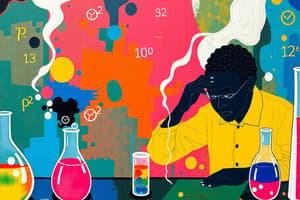Podcast
Questions and Answers
What is the primary function of chlorophyll in the process of photosynthesis?
What is the primary function of chlorophyll in the process of photosynthesis?
- Convert CO2 and H2O into carbohydrates (correct)
- Enhance plant color
- Kill bacteria in plants
- Help plants absorb water
Why is autotrophic nutrition important for plants?
Why is autotrophic nutrition important for plants?
- It helps them make their own food (correct)
- It increases water absorption
- It improves plant color
- It prevents bacterial infections
Which enzyme is secreted by salivary glands to convert starch into sugars?
Which enzyme is secreted by salivary glands to convert starch into sugars?
- Lipase
- Pepsin
- Cellulase
- Amylase (correct)
What is the primary function of peristalsis in the esophagus?
What is the primary function of peristalsis in the esophagus?
Which organ in the human digestive system is responsible for acidifying the medium and activating enzymes like pepsin?
Which organ in the human digestive system is responsible for acidifying the medium and activating enzymes like pepsin?
Where does the complete digestion of carbohydrates, proteins, and fats take place in the human digestive system?
Where does the complete digestion of carbohydrates, proteins, and fats take place in the human digestive system?
What is the role of villi in the small intestine?
What is the role of villi in the small intestine?
Which organ secretes bile stored in the gallbladder?
Which organ secretes bile stored in the gallbladder?
What is the function of the large intestine?
What is the function of the large intestine?
Which enzyme is secreted by the pancreas to aid in digestion?
Which enzyme is secreted by the pancreas to aid in digestion?
What is the main function of the bronchi in the respiratory system?
What is the main function of the bronchi in the respiratory system?
Study Notes
- The video is important for science exam preparation, covering full syllabus revision including chapters on electricity, chemistry, and physics.
- Revision includes key topics like nutrition, autotrophic vs heterotrophic nutrition, and photosynthesis process for plants.
- Photosynthesis equation involves converting CO2 and H2O into carbohydrates in the presence of sunlight and chlorophyll.
- Autotrophic nutrition is crucial for plants as they make their own food, while heterotrophic nutrition involves organisms consuming food made by others.
- Human digestive system functions are essential to understand, including the roles of mouth, buccal cavity, teeth, tongue, esophagus, salivary glands, pancreas, small intestine, large intestine, and more.
- Salivary glands secrete amylase enzyme to convert starch into sugars like sucrose and maltose.
- Esophagus moves food from mouth to stomach through peristalsis movement.
- Stomach acidifies the medium to activate enzymes like pepsin, necessary for digestion.
- Stomach acid also kills bacteria that may enter with food, preventing infections.
- Understanding the functions of each organ in the human digestive system is crucial for exams, including labeling diagrams and explaining processes.- The small intestine is where the complete digestion of carbohydrates, proteins, and fats takes place.
- Carbohydrates, proteins, and fats are digested in the small intestine.
- The small intestine is the largest part of the alimentary canal.
- The length of the small intestine depends on the individual's eating habits.
- Herbivores have a larger small intestine compared to carnivores.
- The structure of the small intestine includes finger-like projections called villi, which aid in the absorption of food into the blood.
- The large intestine absorbs excess water and removes the rest of the material from the body through feces.
- The liver is the largest organ in the body and secretes bile stored in the gallbladder.
- Bile helps in digesting fats and breaking down large globules into smaller ones in the small intestine.
- The pancreas secretes pancreatic juice containing digestive enzymes like amylase, trypsin, and lipase.
- Aerobic respiration involves the conversion of pyruvate into lactate and carbon dioxide.
- The nostrils bring air into the body, and nasal cavities help filter and moisten the air before it reaches the lungs.
- The bronchi are branches that settle the air into and from the lungs, extending from the windpipe.
Studying That Suits You
Use AI to generate personalized quizzes and flashcards to suit your learning preferences.
Description
Prepare for your science exam by revising key topics like nutrition, human digestive system functions, photosynthesis process, and the roles of organs like stomach, small intestine, and salivary glands in digestion. Understand concepts like autotrophic vs heterotrophic nutrition and the importance of each organ in the digestive system.




